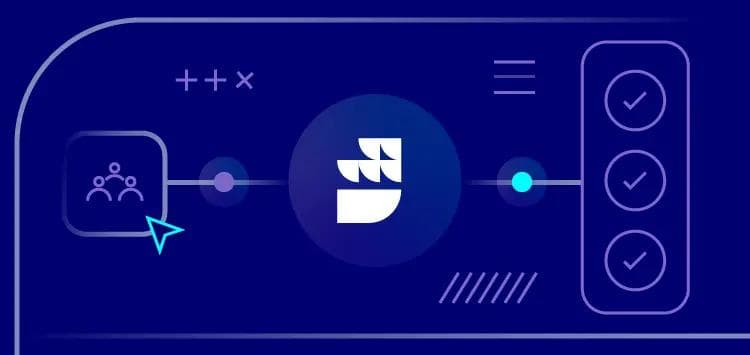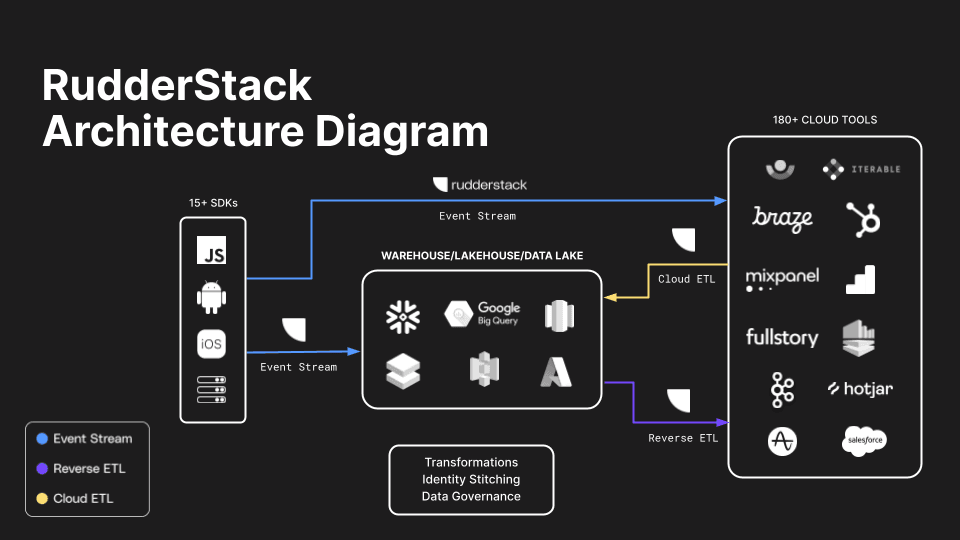The Profiles Handbook: Profiles Overview

This blog is the first of a series exploring our customer 360 solution, RudderStack Profiles, and its various components. Profiles makes building a complete customer view and activating comprehensive customer profiles accessible for every data team.
In this series, we'll delve into different aspects of Profiles, covering everything from models and contexts to identity stitching, entityVars, inputVars, and more. Each post will provide insights and examples to help you better understand and effectively utilize Profiles on your data maturity journey.
What is RudderStack?
First, let’s do a quick refresher on RudderStack so we can understand where Profiles fits in. RudderStack is the Warehouse Native CDP. It's an open-source, enterprise-ready platform that facilitates the collecting, on-the-fly transformation, and routing of client event data to your data warehouse and over 180 other destinations. Its robust transformation system enables the processing of event data in real-time. The platform also includes integrated ETL and reverse ETL pipelines.

Where Profiles fits in
Constructing a customer 360 view is a daunting task due to disparate data sources, complex user identities, varying semantic interpretation of events, and often unstandardized metrics. Recognizing this challenge, we designed Profiles as a strategic solution that streamlines data collection and unification to create complete customer profiles that are ready for activation in downstream tools.
Profiles sits on top of RudderStack’s existing infrastructure and is integrated with the RudderStack UI. The result is a connected, governable, and observable end-to-end system that deploys the integration, real-time transformation, and activation layers together. This packaging drives numerous efficiencies and allows you to ensure seamless data flow from every first-party data source while facilitating enrichment from second and third-party data sources to build truly comprehensive profiles of your customers.
What is Profiles?
Profiles is a component of RudderStack built to enable you to create a complete customer view within your own data warehouse. It embodies the core principle of simplicity, allowing business users to leverage Customer 360 with a user-friendly interface and robust capabilities while eliminating the need for deep SQL or Python knowledge. With Profiles, every company can unlock the true value of their customer data to drive meaningful business outcomes and superior customer experiences.
Profiles, sitting within the greater RudderStack system, solves the technical challenges of identity resolution for you, so your team can focus on driving value with customer profiles not on creating them. Profiles’ job begins after Event Stream and ETL pipelines deliver data from various sources to your warehouse.
To solve the first significant obstacle to attaining a single customer view — data fragmented across different user identifiers — Profiles automates identity stitching. It unites various customer identifiers, including anonymous IDs, from an array of sources, devices, and platforms, to establish a canonical ID for each user. Further, it simplifies the complexity of managing identifiers like anonymous IDs, cookie IDs, device IDs, emails, and phone numbers by building an identity graph and computing transitive closure.
After successfully stitching customer identities, the next challenge is to build a library of traits that provide rich insights into customer behavior. These traits can take various forms from simple ones derived from the most recent 'identify' call to SQL traits that are built upon 'TRACK', 'PAGE', or 'IDENTIFY' events. As organizations expand, the diversity and complexity of traits increases. Different teams, guided by unique goals and methodologies, often create their own set of traits. Moreover, some traits are tied to crucial organizational metrics like revenue, or they involve complex definitions of funnels or predictive ML models. As a business scales, the sheer complexity and diversity of these traits pose a significant challenge to building a complete customer view.
To address this challenge, Profiles provides a unified system for trait definitions. This drives consistency across the organization while delivering enough flexibility to accommodate the needs of different teams. Profiles simplifies and standardizes the trait creation process, making it accessible to business users without requiring SQL or Python proficiency. The end result is a robust trait library that you can use to keep every team on the same page while fostering a comprehensive, nuanced understanding of your customers.
The pieces of Profiles combine to efficiently deliver accurate, comprehensive customer profiles that are ready for activation in downstream tools where every team in your organization can use data to drive bottom-line impact.
Applications of Profiles
The power of Profiles becomes evident when we consider the multitude of use cases it serves:
- Personalization – To deliver deeply personalized experiences, you can leverage Profiles' low latency API to access customer data in real-time. This facilitates immediate customization of content, offers, and interactions tailored to individual customer profiles.
- Activation – With RudderStack’s built-in Reverse-ETL function, you can send complete customer profiles to every downstream tool to fuel insight for marketing, sales, customer success, and every other team.
- Machine Learning – You can use Profiles' traits to feed machine learning models that predict customer behavior. These include models for churn prediction, lifetime value (LTV) calculation, and attribution modeling. Furthermore, the outputs from these models, which form new user traits, can be reintegrated into the Profiles library. You can then serve these via the Profiles API or through RudderStack's reverse ETL, forming a seamless cycle of data utilization and enhancement.
Benefits of Profiles
Building your own system for a customer 360 is a massive undertaking, and existing off-the-shelf solutions are underwhelming. That’s why we built Profiles. We’re solving the technical challenges so you don’t have to. And because Profiles is a part of the greater RudderStack infrastructure, it delivers benefits that are out of reach with other approaches. To recap, here’s how Profiles makes a complete customer view accessible for every company and every team:
- Streamlines data management — Profiles seamlessly integrates with RudderStack's existing system, unifying collection, transformation, and activation under a single platform. It streamlines data management and enables more robust integration across your data tooling.
- Eliminates the learning curve — We built Profiles with simplicity as its core principle. It eliminates the need for SQL or Python expertise, empowering all business users to harness the full potential of Customer 360 without a steep learning curve.
- Solves identity stitching — With its innovative Identity Stitching feature, Profiles tackles the first roadblock in achieving a complete customer view – fragmented data. By intelligently linking different identifiers from various sources, it unifies disparate customer data into an activation-ready comprehensive profile.
- Builds a consistent and diverse traits library — Profiles provides a unified system for defining traits. It enables consistency across the organization, handles a diverse range of traits, and simplifies the trait creation process for all users, regardless of technical proficiency.
- Serves multiple use-cases — Profiles supports a multitude of applications, from personalization and activation to numerous machine learning use cases. Whether it's serving personalized content via a low latency API or feeding traits into ML models for churn prediction, Profiles enables you to get full value out of your customer data.
- Unlocks deeper insights with advanced trait definition — Profiles isn't just about the basics. It extends its capabilities to support traits derived from secondary, complex concepts such as sales funnels, organizational metrics, and machine learning models. In Profiles, Funnels and Metrics are first-class citizens, not peripheral entities. This functionality allows you to define these entities based on their specific requirements and convert these metrics into insightful traits. With Profiles, understanding your customers' journey through your sales funnel or locating each user across the histogram of customer metric values is as simple as defining a trait.
- Scales as you grow —With a library of reusable projects for commonly used data sources, Profiles prevents redundant work. It enables you to focus on unique optimizations, ensuring efficient use of resources and scalability.
Whether you're new to data warehousing or an experienced practitioner, this series is designed to offer valuable insights and practical guidance for leveraging the power of Profiles. Stay tuned for our next post where I’ll write about models in Profiles. Happy reading!
Published:
May 23, 2023

Salesforce data enrichment: Best tools for 2025
Without proper enrichment, Salesforce customer records can become stale, incomplete, and increasingly disconnected from reality. Learn about the best tools for real-time syncing, identity resolution, and deep integration with modern data stacks.

Data matching techniques: Best practices & challenges
In this article, we’ll explore the core techniques behind data matching—such as identity resolution and record linkage—along with the common challenges teams face and the best practices for improving match quality at scale.

A groundbreaking approach to creating and delivering complete customer profiles
RudderStack Profiles introduces a groundbreaking approach to solving identity resolution. It enables every data team to power their business with reliable, complete customer profiles. In this blog, we show you how.







